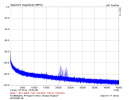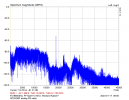Marantz PM-10 Comparison
(bridged NC500OEM with Marantz buffer+preamp)
Source = -111 dB SINAD Panasonic UB9000
Instrument = E1DA Cosmos ADC; Grade A
Edit: I just left this in the 43V input mode. If I matched the input sensitivity of the E1DA to the actual output, you get higher SINAD numbers. I ran the bandwidth from 20 to 22050 Hz instead of 20 to 20000.
My tests are noisier and more distorted that @amirm 's. This UB9000 source / E1DA gives me a Marantz PM-90 measures -79 dB on my system, but Amir testing the identical physical unit (actual unit) got to -87 to -88 dB.

The inflection point for the bridged PM-10 is around 25W.
I wasn't able to get the setup below -102.4 dB SINAD (0.000759%) which is due to my test gear. It's possible that it also has the 5 or 10W inflection point and I just cannot get the nadir as low. The 20 mW and 300W are equal on the NCx500 and the PM-10,

I don't see a big difference between ~5W vs ~50W


But as you go higher, you do see the noise well above 100 kHz
200W and 360W


For the 19/20kHz IMD, the spikes around the audible range are LOWER than the AHB2 but you have higher spikes above 30 kHz


(bridged NC500OEM with Marantz buffer+preamp)
Source = -111 dB SINAD Panasonic UB9000
Instrument = E1DA Cosmos ADC; Grade A
Edit: I just left this in the 43V input mode. If I matched the input sensitivity of the E1DA to the actual output, you get higher SINAD numbers. I ran the bandwidth from 20 to 22050 Hz instead of 20 to 20000.
My tests are noisier and more distorted that @amirm 's. This UB9000 source / E1DA gives me a Marantz PM-90 measures -79 dB on my system, but Amir testing the identical physical unit (actual unit) got to -87 to -88 dB.
The inflection point for the bridged PM-10 is around 25W.
I wasn't able to get the setup below -102.4 dB SINAD (0.000759%) which is due to my test gear. It's possible that it also has the 5 or 10W inflection point and I just cannot get the nadir as low. The 20 mW and 300W are equal on the NCx500 and the PM-10,
I don't see a big difference between ~5W vs ~50W
But as you go higher, you do see the noise well above 100 kHz
200W and 360W
For the 19/20kHz IMD, the spikes around the audible range are LOWER than the AHB2 but you have higher spikes above 30 kHz
Last edited:



